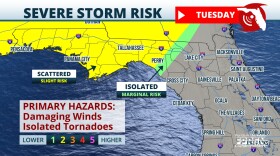Resource Links | Important Numbers | Terms To Know | Storm News
It’s that time of year again. Florida’s hurricane season lasts from June 1 until November 30. If you’re new to the state or just in need of information on how to keep yourself and your loved ones safe, the WMFE news team has compiled links to some of the most important information you’ll need.
Stay Safe this hurricane season and remember, WMFE is here to keep you up-do-date with life and property saving information.
RESOURCE LINKS
CENTRAL FLORIDA COUNTY EMERGENCY INFORMATION, SHELTERS AND EVACUATION ZONES:
Brevard | Lake | Marion | Orange | Osceola | Polk | Seminole | Sumter | Volusia
STATE/NATIONAL RESOURCES:
NOAA | Fla. Div. Of Emergency Management | FEMA
MORE RESOURCE LINKS:
Disaster Supply Kit Checklist
Flood maps
Know your Zone
Evacuation plan
Shelters
Preparing your homes
Medicine refills
Hurricane safety for people with dementia
Special Needs Registry
Planning for your pet
Horse owner hurricane preparation
What to do if you lose power
Power outage map
Dangers after a hurricane
Cleanup after a hurricane
Food Safety
Generator safety
Where to find gas
Report price gouging
Mosquitoes after a storm
Encountering wildlife after a hurricane
Beekeeper preparedness
IMPORTANT NUMBERS
Emergency help: 911
SAIL Hotline: 1-800-342-3557
FEMA: 1-800-621-FEMA (3362)
Non Emergency Support Services: 211
TERMS TO KNOW
Language surrounding hurricanes and other storms can often be confusing. With that in mind, we’ve also compiled a list of terms and their definitions.
Tropical Cyclone: Low pressure system that forms over warm tropical waters.
Tropical Depression: A tropical cyclone with maximum sustained winds of 38 mph or less.
Tropical Storm: A tropical cyclone with maximum sustained winds of 39 to 73 mph.
Hurricane: A tropical cyclone with maximum sustained winds of 74 mph or higher.
Major hurricane: A tropical cyclone with maximum sustained winds of 111 mph or higher. These are category 3, 4 or 5 hurricanes.
Tropical storm warning: A tropical storm warning is issued when sustained winds of 39 to 73 mph are expected in an area within the next 36 hours.
Tropical storm watch: A tropical storm watch is issued when tropical storm conditions are possible within the next 48 hours.
Hurricane Warning: A hurricane warning is issued when sustained winds of 74 mph or greater are expected in an area within the next 36 hours.
Hurricane Watch: A hurricane watch is issued when hurricane force winds are possible in an area within the next 48 hours.
Eye: The center of the hurricane.
Eyewall: The band or ring of clouds that surrounds the eye of a hurricane.
Landfall: The moment the center of the hurricane reaches the coastline.
Outer bands: An outer ring of rainfall and thunderstorms that surrounds a hurricane. Usually this is the first part of the storm to make landfall.
Storm surge: A rise in sea level corresponding with a hurricane or other intense storm at sea.
Cone of uncertainty: A diagram showing the projected path of a tropical storm or hurricane over the next five days.
Spaghetti plot: A diagram showing multiple paths a tropical storm or hurricane could take based on different prediction models.
Hurricane names: Any tropical cyclone that becomes a tropical storm or hurricane gets a name. Here’s the list of this year’s names.
National Hurricane Center: The National Hurricane Center or NHC issues watches, warnings and advisories for tropical weather.
Hurricane season: The Atlantic hurricane season runs from June 1 through November 30. This is when tropical cyclones are most likely to form in the Atlantic.
The peak of hurricane season: September 10 is the peak of hurricane season. Most hurricanes form between mid-August and mid-October.
Saffir Simpson Hurricane Wind Scale (ranking): The scale ranks a hurricane’s potential to do property damage based on its maximum sustained wind speeds. Hurricanes can be category 1, 2, 3, 4, or 5 storms.
Latest Storm News
-
Colorado State University researchers cite hurricane-favorable wind shear conditions and warm ocean waters.
-
Strong spring storm system to elevate risk for strong storms across Florida Tuesday night and Wednesday
-
Severe storms with flooding risk across north Florida through Wednesday
-
A developing storm should produce multiple rounds of heavy rain over parts of Florida on Friday and Saturday. Localized flooding is expected over parts of South Florida. Severe thunderstorms are possible along the immediate Gulf Coast of Florida.
-
The countdown to hurricane season has begun, and Florida emergency management offices are sharing their safety tips to empower residents to act ahead of potential storms.
-
As spring break approaches and travelers make their way to the Sunshine State’s beach towns, local authorities and lifeguards want you and your family to prioritize safety when soaking up the sun.
-
A storm system developing over the Plains Thursday will create a risk for strong thunderstorms over the Panhandle and the I-10 corridor in North Florida late Friday and through the day Saturday.
-
El Nino contributed to Florida's cool winter, La Nina to arrive by summer and could influence hurricane season
-
William “Chip” Maxham joined the Florida Public Radio Emergency Network (FPREN), the WUFT Public Media Weather team and the South Carolina Emergency Information Network (SCEIN) as a meteorologist in January 2024.
-
Cool and Damp Weekend Ahead
-
The National Hurricane Center (NHC) will be implementing a new experimental cone graphic to display critical watches and warnings for inland counties during hurricane season.
-
The Florida Division of Emergency Management (FDEM) and the National Weather Service are recognizing this week as Severe Weather Awareness Week. Drawing attention to several weather hazards, the campaign aims to share information on how to prepare and respond to natural disasters.













